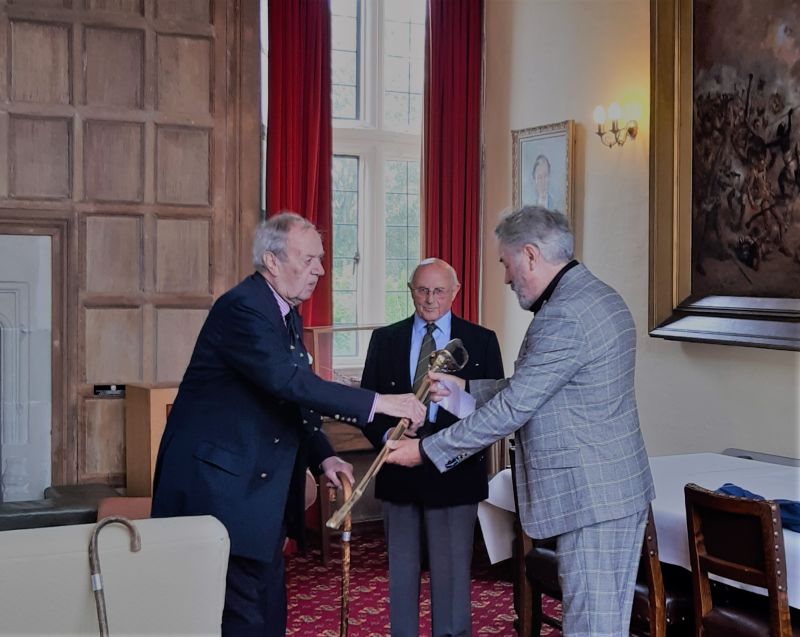Home of the Infantry Regiments of Berkshire and Wiltshire
What A Discovery! Sword belonging to Lieutenant William John De La Poer Beresford-Pierse, who was present and survived the Battle of Maiwand is gifted to the museum.
‘What A Discovery!’
We were delighted to welcome the arrival of John Devonport and his wife with a very special gift to the museum on a very poignant day. 27 July 2020 marks the 140th Anniversary of the Battle of Maiwand. Here at the museum we remember the battle because of the connection it has with our own Berkshire regiment.
1880 Battle of Maiwand
The Battle was part of a larger conflict called "The Great Game" which was a political and diplomatic confrontation that existed for most of the 19th century between the United Kingdom and Russia over Afghanistan and neighbouring territories in Central and South Asia.
Early in 1880 the 66th Regiment was ordered to Afghanistan, which the British had invaded in the previous year after the massacre of their envoy and his escort at Kabul.
The Regiment was commanded by Brigadier-General Burrows and consisted of two Indian cavalry regiments, two Indian infantry regiments, a battery of Royal Horse Artillery, another of smoothbore guns, and six companies of the 66th Regiment, under Colonel Galbraith.
On the morning of 27 July, the cavalry advance guard reached Mahmudabad, on the arid plain of Maiwand, about 45 miles from Kandahar. The village stood on the edge of a deep, dry, watercourse and on the plain beyond it they saw the Afghans - not the small force they had led to expect but a great Army, streaming eastwards towards Kandahar. It was later established that the force consisted of 4,000 cavalry, 8,000 infantry, 30 guns and some 20,000 irregulars, many of them the religious fanatics known as Ghazis.
After several hours desperate fighting, the enemy had broken through to the rear of the British line and the 66th were fighting them on both sides. Colonel Galbraith, who was carrying the Queen’s Colour at this stage, rallied most of the survivors of his battalion in the watercourse, but the position was very exposed and he decided to retire to Khig, where use might be made of houses and garden walls. During the withdrawal Colonel Galbraith, still grasping the Colour, was killed.
About a hundred of the Regiment made their second stand in a walled garden. Surrounded by hordes of irregulars they fought on until only two officers and nine other ranks were left. This small group charged out of the garden, formed up back to back and continued to fire until the last of them fell.
The 66th received no official recognition for its services at Maiwand. No Victoria Crosses were awarded for the good reason that no one qualified to make recommendations had survived. It was a defeat, so no Battle Honour could be given for it. Nor, apparently, did it warrant a bar to the Afghan Medal. However, no one had anything but praise for the 66th. Even the Afghans, who valued courage above all other virtues, had been impressed, and one of their Colonels who had been present spoke in glowing terms of their admiration for the Regiment’s conduct. General Primrose, in his official despatch to the Commander-in-Chief, India, wrote:
". . . . history does not afford any grander or finer instance of gallantry and devotion to Queen and Country than that displayed by the 66th Regiment on the 27th July 1880."
A small dog named "Bobbie", who was the pet of a Sergeant in the Regiment, was wounded in the battle but survived and became the Regiment's mascot. He was eventually brought back to England where he was presented to Queen Victoria at Osborne House on the Isle of Wight.
It is an interesting fact that the Regiment’s Medical Officer, Surgeon Major A F Preston, who was wounded in the battle, was the inspiration for Sir Arthur Conan Doyle's character, Doctor Watson, who describes in A Study in Scarlet how he was shot while attending to a fallen soldier.
The loss of the Colours at Maiwand, coming soon after a similar loss, led to the end of the practice of carrying them into battle. In 1881 as part of the Cardwell reforms of the army the 49th and the 66th Regiments were amalgamated to become the 1st and 2nd battalions of the "Princess Charlotte of Wales’s (Berkshire) Regiment".
Today we mark the anniversary by receiving the sword that belonged to Lieutenant William John De La Poer Beresford-Pierse, who survived the Battle of Maiwand.
He is important in the Regiment’s history and a very lucky man to have survived the battle of Maiwand and the subsequent retreat to Kandahar. During the battle he commanded ‘H’ Company, and as such was in the thick of the action. He returned to the battlefield to locate and identify as many from the regiment who fell as possible. He would have known all the officers having been with the regiment since 1872.
When the Regiment went into battle at Maiwand the officers would have been armed with both a pistol and a sword. We cannot say that the sword that we have been gifted was carried into battle at that time, but we suspect it was. As a young officer in 1872 William would have had his own sword, which he would have used and kept for the remainder of his service. The fact that he had engraved his initials on the blade shows how much that particular weapon meant to him.
The sword has for 50 years been in the well loved collection of John Devonport and today marks it new journey and story with us here at the Wardrobe. We hope to have the sword displayed with Bobbie very soon for people to come and see.

